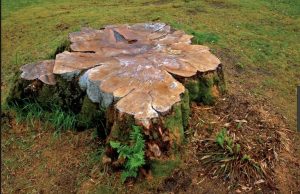I’m going to do a whole post about stump grinding and stump removal because it’s such an important part of how we treat a garden. That and the fact that I’ve spent the whole day doing just that so it’s really fresh in my mind.

We’ve seen some wonderful creations made from tree stumps – from the beautiful birds carved into tree trunks at Nymans Gardens in West Sussex, to a huge bear in a friend’s garden. It’s truly amazing what some people can do with what appears to be an unwieldy chain saw. How do they perform such intricate carving with such a large implement?
So that’s one option – turn your tree trunk into a work of art.
But that’s not for everyone because it can be difficult to find the right artist, expensive or simply overpowering for a small garden.
Another way of dealing with the leftovers of felled trees is to have the stump completely removed. This sounds ideal in theory but in practice can leave you with a very large hole – plus a lot of mess made by the machine that was needed to pull out the roots! It’s simply not practical for every type of tree in a small garden. It might work well for a small fruit tree, for example, but if you have a mighty oak removed (sadly) then you’re just not going to want the massive disruption it leaves behind. And that’s only if you can get the machinery into your garden!
So the best option is often to have the stump ground out. You can either hire a stump grinding machine and do it yourself – which isn’t quite as easy as it sounds – or hire a professional. I’d go for the latter any day because stump grinding is a horrible chore. The wood flies everywhere so you need protective clothing and frankly in my books it’s not worth the bother.
Hire the professionals and get a job done well in a fraction of the time. They’ll bring in the right sort of grinder to do the job in the space allocated and be out of your hair in no time. Job done and the stump will be ground down to ground level or below so you can turf over it.
So that’s how we deal with all the stumps left when we’ve removed trees. It’s not the only way because you could turn large stumps into seats or plant holders, but it’s a neat way to remove obstacles to your overall plan if you’re unable to incorporate such a feature.
Happy grinding!
You can see more about how to plan your garden here